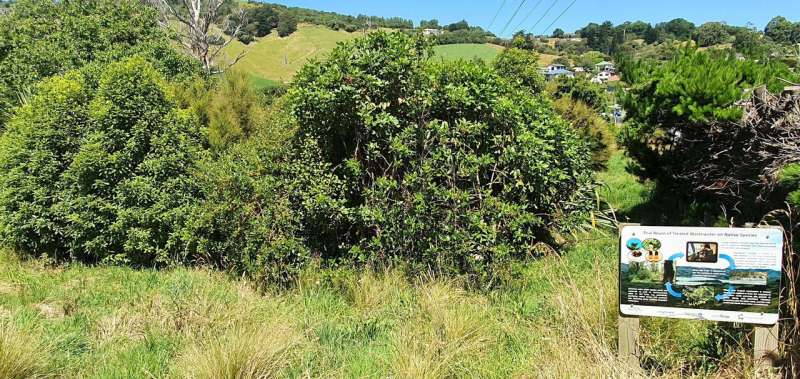This article has been reviewed according to Science X's editorial process and policies. Editors have highlighted the following attributes while ensuring the content's credibility:
fact-checked
trusted source
proofread
Feeding native ecosystems with waste

UC researchers are pioneering the use of treated sewage to restore native plants on Te Pātaka-o-Rākaihautū Banks Peninsula.
Research by Te Whare o Wānanga o Waitaha | University of Canterbury (UC) Environmental Science academics Dr. Maria Jesus Gutierrez-Gines and Professor Brett Robinson shows treated sewage that would otherwise be discharged into waterways could be used for land irrigation.
Drawing knowledge from UC Adjunct Fellow Dr. Colin Meurk, an expert in native ecosystems, the team is working to identify the best match of native plant and nutrients for planting as well as benefits to the environment and wildlife.
"What is irrigated onto the native trees has a low pathogen risk—it looks a lot like drinking water," Professor Robinson says.
Containing high concentrations of nitrogen and phosphorus, treated sewage discharged into waterways causes water degradation, algal growth and fouling on boats.
"Continuing to discharge treated sewage into our harbors and waterways will cause ongoing damage to ecosystems, food chains and mahika kai," Dr. Meurk says.
Professor Robinson says one solution is irrigation onto land, supporting native ecosystems and reducing contaminants entering waterways.
"There have been lots of other side benefits to it," Professor Robinson says. "Native plants like kānuka and mānuka have antimicrobial properties further reducing the risk of pathogens, while others can mitigate environmental contamination like reducing nitrate leaching.
"These could be used on paddock margins to intercept waste from animals and reduce the pathogen load into waterways."
Professor Robinson says this is an example of turning what could have been an environmental problem into a solution that benefits both the land and the community with far-reaching possibilities. "It demonstrates the circular economy, where material is used to regenerate nature instead of becoming waste."
Currently, New Zealand imports phosphate fertilizer from Morocco and West Sahara, which can be expensive, has supply constraints and contains a high level of cadmium, a toxic heavy metal which can cause kidney failure. "We don't want that in our soil, so high-quality treated sewage could be the solution.
"With cadmium levels increasing in our soils over the past 100 years, New Zealand has reached a point where we can no longer export some offal products and some of our vegetables exceed food safety standards for cadmium levels," Professor Robinson says.
Dr. Gutierrez-Gines and Professor Robinson have demonstrated the potential to generate valuable native products such as essential oils, honey, fibers and timber, in areas that have been irrigated with treated sewage. However, there could be resistance from consumers.
"Sewage can contain components which you don't want in the food chain, such as pathogens, hormones from contraceptive pills, or personal care products, so this needs to be investigated and addressed," Professor Robinson says.
"Using traditional native plants like harakeke and totara could provide cultural and economic benefits while avoiding products related to the food chain," Dr. Maria Gutierrez Gines says.
Provided by University of Canterbury




















